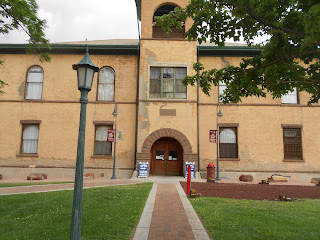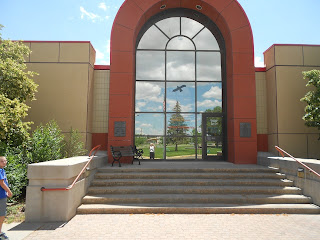 |
| Waggoner Mansion, Decatur Texas |
A busy highway corridor that stretches from Decatur Texas, northwest of Dallas, all the way to Pueblo Colorado also serves as a trip back to the days of the historic cattle ranches.
US Highway 287 is the main highway for those traveling from the Dallas/Fort Worth area northwest to Amarillo Texas and beyond. This is a roadway that cuts through the land that at one time was home to famous Texas ranches such as the
XIT, the
JA Ranch and the
Waggoner Ranch. Each of these ranches have their own unique story to tell. The XIT which spanned over 3 million acres was responsible for the funds that built the Texas state capitol building in Austin.
The JA Ranch is the story of the legendary Charles Goodnight, the founder along with Oliver Loving of the famed Goodnight-Loving Trail, who today is considered the
Father of the Texas Panhandle. The Waggoner Ranch is the story of a father and son who built an enormously successful million acre ranch to the west of Wichita Falls Texas and then found out the ranch land was sitting on large oil deposits.
Good Trips Stops to Add to Your Road Trip Planner
 |
| Red River Valley Museum, Vernon Texas |
If your
western road trip takes you to this part of Texas, you will want to consider setting some time aside to explore several museums and historic sites all along this stretch of US Hwy 287. Among the sites you'll want to add to your Texas trip planner are
El Castile, the Waggoner mansion in Decatur Texas, the
Red River Valley Museum in the town of Vernon, the town of
Electra which was named after the daughter of W.T. Waggoner,the
Goodnight Home in Goodnight Texas, the ranch home of famous Texas rancher Charles Goodnight and the
Armstrong County Museum in Claude Texas just about twenty miles east of Amarillo. All of these sites and more are located on US Hwy 287. The El Castile mansion is located on the east side of Decatur on E. Main Street up on a small hill. Two of our related articles you'll find interesting are The
Red River Valley Museum and the famous
King Ranch of Texas. The show saddle photo shown below is on display in the Waggoner Room inside the Red River Valley Museum.
The Waggoner Ranch and the Three D Brand
The story of the building of the Waggoner Ranch is very interesting. Although taking place much earlier during the nineteenth century and early twentieth century, parts of the Waggoner story resemble fictional plot lines seen on the television show "
Dallas". The Waggoner Ranch story began with a pioneering patriarch who passed on the family ranch business to his son and then on to the son's children. In this case, the father was Daniel Waggoner and his son, W.T. "Tom" Waggoner. The Waggoner Ranch registered and used the
Three D Brand. In 1866 the brand was altered with the D's in reverse. This made the brand unique and harder to alter. A good move considering the cattle rustling going on at the time.
 |
| Show saddle from Waggoner Ranch |
Like many ranching stories, a single good chance event laid the seeds for what would become a true ranch empire in every sense of the word. In the book,
Historic Ranches of the Old West, author Bill O'Neal tells the story of how Daniel Waggoner brought his family to Texas from Tennessee in the mid 1840's. Daniel's son, W.T., was born in 1852. The elder Waggoner was among the very earliest of Texas ranchers, having established himself prior to the Civil War. The only other Texas ranch of note I'm aware of established prior to the Civil War was the large King Ranch in southeast Texas.
In 1870 the father and son drove a herd of Longhorns from Clay County Texas, south of Wichita Falls, up to Kansas. At the time the Waggoners had a ranch in Wise County Texas and had wintered a herd in Clay County. The sale of the herd was quite successful and the pair returned to Texas with $55,000. It was from that success that they were able to move their ranch further west to the western part of Wichita County. Eventually their herd of cattle grew to the point that they had to lease grazing land in Indian Territory. The Waggoners leased some 650,000 acres in present day Oklahoma. In fact, several ranchers had leased land from the Indians including the legendary rancher Burk Burnett who is the namesake of present BurkBurnett Texas located in western Wichita County.
By the time W.T. Tom Waggoner turned twenty-seven years of age, his father turned over to him the ranching operations. Daniel Waggoner would have been fifty years old. The Waggoner Ranch began breeding Shorthorn cattle and then Herefords were raised beginning in the 1890's. By the year 1900, the Waggoner Ranch ran some thirty miles east and west and twenty five miles north and south. Most of the ranch land was in Wilbarger and Wichita Counties. During this time a part of the Waggoner land was sold off to farmers and additional new land was purchased. The family also built a mansion in Decatur Texas and named it "
El Castile", shown in the photo at the top of this page. The home is still there today and although it is privately owned and no tours are available, it still attracts tourists today. If you're in the
Decatur Texas area, about
sixty miles northwest of Dallas, you might want to stop by and view this historic home.
The elder Waggoner passed away in 1904. Tom Waggoner then moved to Fort Worth to manage the family business but also spent time up in the Decatur mansion.
Oil Leads to New Wealth
The second major event for the Waggoner Ranch was the discovery of oil in 1903. The oil was discovered while the ranch was drilling wells for water. The water was badly needed for the 60,000 heads of cattle and every time they struck oil it was considered a failure. What was wanted was water not oil. Eventually, Tom Waggoner came to understand the value of his oil and after building the Waggoner Refinery, he also built a chain of gas stations sporting his
Three D brand. The ranch formed an oil partnership at the time with Texaco. W.T. Tom Waggoner died in 1934.
Shop Amazon Warehouse Deals - Deep Discounts on Open-box and Used Sports Equipment
After his death, the ranch assets were so great and so diverse that the family's property was put into what was called the
Waggoner Estate. The revenue from oil turned the ranch into a conglomerate of banks, oil wells, feed lots and horse breeding stables. Waggoner had also built
Arlington Downs, a horse race track between Fort Worth and Dallas.
The Waggoner family also donated funds for civic projects. Author Lewis Atherton in his excellent book,
The Cattle Kings, writes that the family donated three buildings for the campus of Texas Womens College which today is
Texas Womens University in Denton Texas. The family also provided funds for the refurbishing and enlarging of the First Methodist Church of Fort Worth Texas.
 |
| Theater in Electra Texas |
The photo at right is of the old Grand Theater in
Electra Texas. Electra Texas is at the site of the Waggoner Ranch and the town itself is the namesake of W.T. Waggoner's daughter "
Electra".
The story of Electra Waggoner and W.T. Waggoner's granddaughter Electra Waggoner Biggs. is quite interesting in itself.
Please see our article on Electra Texas and the famed sculptor
Electra Waggoner Biggs.
Two additional Western Trips photo articles you may enjoy are on the links below...
A Visit to "Cowtown" Fort Worth Texas
The Bluebonnets of Burnet Texas
T
he Waggoner Ranch continues operations to the day of this writing. The horse breeding operations are very successful. Due to a rift among the Waggoner heirs, some of whom wish to liquidate the ranch, a 1993 court order was issued to break it apart and sell it off. As of this writing there apparently has been no sale of this massive ranch. It is currently run by trustees. One of the very unique aspects of this ranch is that it has survived and prospered for so long under the same extended family ownership.
An interesting side note is that the world's largest ranch today is the 6,000,000 acre
Anna Creek station in Australia. The largest contiguous U.S. ranch
is the Waggoner Ranch in Texas.
Traveling on US Hwy 287 can be a very historic experience. There are many unique sites to visit in addition to the ones mentioned in this story. Before making the journey, be certain to set time aside for these fun and educational historic sites. Collectively, they tell much about the history of the early Texas ranches and the hard working people who built them.
(Article and photos copyright Western Trips)



































.jpg)
